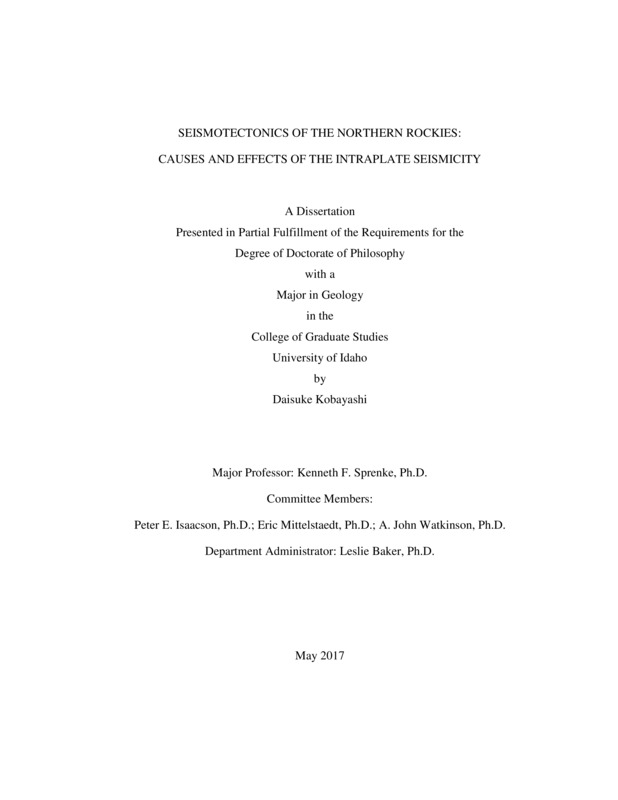Seismotectonics of the Northern Rockies: Causes and Effects of the Intraplate Seismicity
Kobayashi, Daisuke. (2017). Seismotectonics of the Northern Rockies: Causes and Effects of the Intraplate Seismicity. Theses and Dissertations Collection, University of Idaho Library Digital Collections. https://www.lib.uidaho.edu/digital/etd/items/kobayashi_idaho_0089e_11117.html
- Title:
- Seismotectonics of the Northern Rockies: Causes and Effects of the Intraplate Seismicity
- Author:
- Kobayashi, Daisuke
- Date:
- 2017
- Keywords:
- earthquake seismology elastic thickness free-air gravity Northern Rockies seismotectonics Yellowstone
- Program:
- Geology
- Subject Category:
- Geophysics; Geology
- Abstract:
-
This dissertation presents four studies that explore potential causes and effects of the seismicity in the Northern Rockies.
The focus of Chapter 1 is on spatial correlations between the seismicity and the upper mantle structures. Tomography models suggest a strong low-velocity anomaly along the axis of the Yellowstone Tectonic Parabola. A tomography model, as well as heat flow, corrected geoid height, and shear wave splitting data, suggest a low-velocity body along the axis of another seismic parabola formed by the Centennial Tectonic Belt and Intermountain Seismic Belt (ISB). This similarity points to a common mechanism for both seismic parabolas: a passive rising of buoyant mantle overlain by a moving lithosphere.
In Chapter 2, the effects of the historical and hypothetical earthquakes on the Yellowstone magmatic system are assessed by calculating a static stress transfer from each event. The second mainshock of the 1959 Hebgen Lake sequence effectively unclamped the magma reservoir, which could have led to a magma overpressure. Among the 13 hypothetical MW7.1-7.5 earthquakes, events at the second mainshock and largest aftershock of the Hebgen sequence, as well as the one on the Upper Yellowstone Valley fault, show the pattern of normal stress changes favorable to promote a Yellowstone eruption.
Chapter 3 presents an interpretation of the 2015 Sandpoint, Idaho earthquake sequence that occurred in the Lewis Clark Fault Zone (LCFZ). The fault plane solutions show reverse sense of oblique slips on a southeast-dipping nodal plane, which is likely to represent a reactivation of the Purcell Trench fault. The Sandpoint earthquakes, along with the adjacent reverse-faulting events, constrain the western extent of the northeast-southwest extension of the LCFZ.
In the last chapter, I estimate the effective elastic thickness (Te) of the Northern Rockies, using the free-air admittance method. The effect from the upper mantle density heterogeneity is taken into consideration. The result shows a Te variation in which the relatively narrow transition zone from small to large (>10 km) Te coincides with the ISB, as well as a limited effect from the upper mantle. The Te estimate largely agrees with the Te map from the Bouguer coherence method.
- Description:
- doctoral, Ph.D., Geology -- University of Idaho - College of Graduate Studies, 2017
- Major Professor:
- Sprenke, Kenneth F
- Committee:
- Isaacson, Peter E; Mittelstaedt, Eric; Watkinson, John
- Defense Date:
- 2017
- Identifier:
- Kobayashi_idaho_0089E_11117
- Type:
- Text
- Format Original:
- Format:
- application/pdf
- Rights:
- In Copyright - Educational Use Permitted. For more information, please contact University of Idaho Library Special Collections and Archives Department at libspec@uidaho.edu.
- Standardized Rights:
- http://rightsstatements.org/vocab/InC-EDU/1.0/

